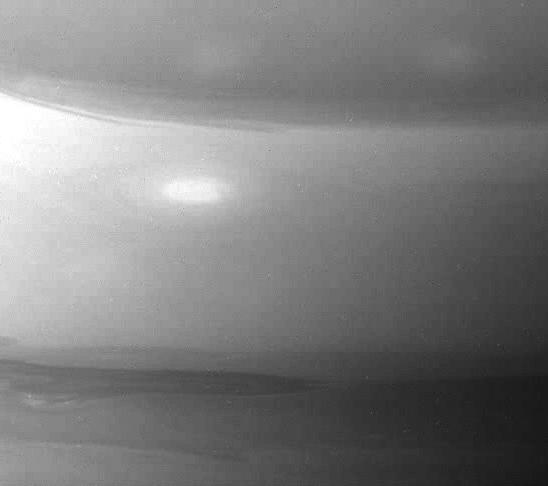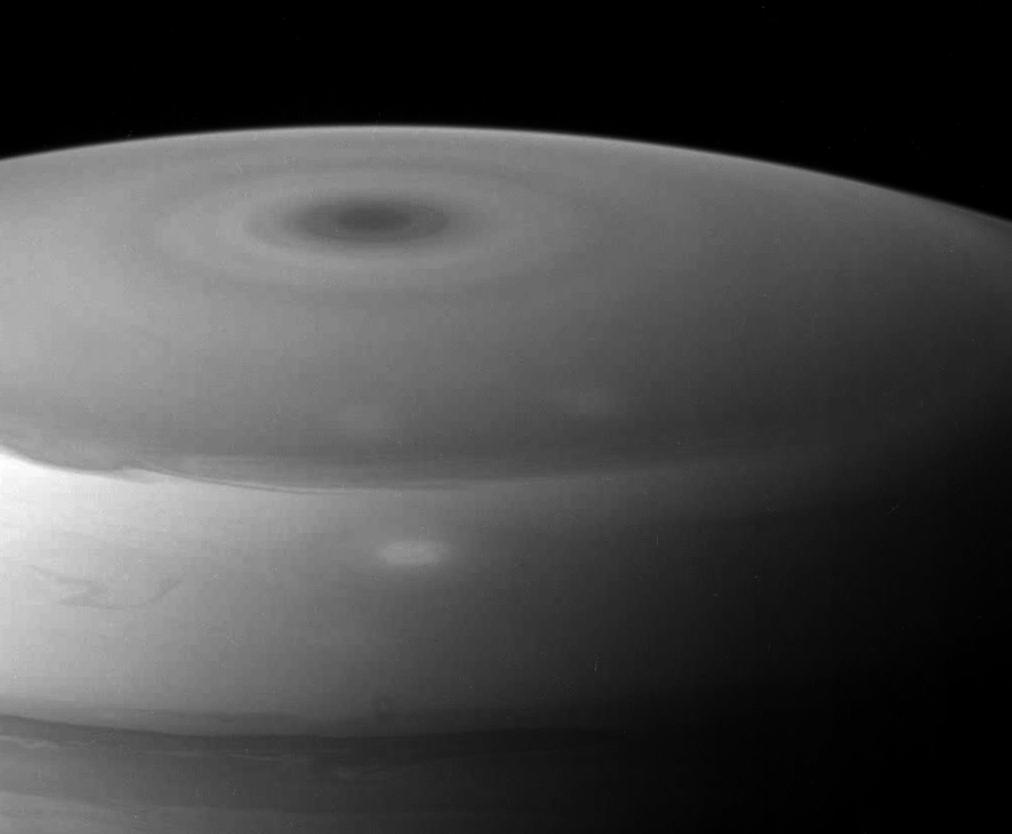| The Cassini-Huygens mission |
 Original image 1014X810 tif 417kB PA05427
Original image 1014X810 tif 417kB PA05427
Original Caption Released with Image:
Saturn's southern polar region exhibits concentric rings of clouds which encircle a dark spot at the pole. To the north and toward the right, wavy patterns are evident, resulting from the atmosphere moving with different speeds at different latitudes.
The image was taken with the Cassini spacecraft narrow angle camera on July 13, 2004, from a distance of 5 million kilometers (3.1 million miles) from Saturn, through a filter sensitive to wavelengths of infrared light centered at 889 nanometers. The image scale is 29 kilometers (18 miles) per pixel. Contrast has been enhanced slightly to aid visibility.
The Cassini-Huygens mission is a cooperative project of NASA, the European Space Agency and the Italian Space Agency. The Jet Propulsion Laboratory, a division of the California Institute of Technology in Pasadena, manages the Cassini-Huygens mission for NASA's Office of Space Science, Washington, D.C. The Cassini orbiter and its two onboard cameras, were designed, developed and assembled at JPL. The imaging team is based at the Space Science Institute, Boulder, Colo.
For more information, about the Cassini-Huygens mission visit, http://saturn.jpl.nasa.gov and the Cassini imaging team home page,
South up South up
 Original image 1166X649 tif 173kB PA05425
Original image 1166X649 tif 173kB PA05425
Two weeks after orbit insertion, Cassini glanced back at Saturn, taking in the entire planet and its expansive rings. Currently it is summer in Saturn's southern hemisphere. Notable here is the bright spot located near the planet's southern hemisphere, where the line from the day and night side of the planet meets. The angle of illumination hints at Saturn's tilt relative to the Sun.
The image was taken in visible red light with the Cassini spacecraft wide angle camera on July 13, 2004, from a distance of about 5 million kilometers (3.1 million miles) from Saturn. The Sun-Saturn-spacecraft, or phase angle of this image is 95 degrees. The image scale is 299 kilometers (186 miles) per pixel. Contrast has been enhanced slightly to aid visibility.
The Cassini-Huygens mission is a cooperative project of NASA, the European Space Agency and the Italian Space Agency. The Jet Propulsion Laboratory, a division of the California Institute of Technology in Pasadena, manages the Cassini-Huygens mission for NASA's Office of Space Science, Washington, D.C. The Cassini orbiter and its two onboard cameras, were designed, developed and assembled at JPL. The imaging team is based at the Space Science Institute, Boulder, Colo.
この画像は少し強調処理されている。白斑が写っている。
South up South up
 Original image 548X486 tif 249kB PA05430
Original image 548X486 tif 249kB PA05430
Original Caption Released with Image:
Details in Saturn's southern polar region highlight the often turbulent nature of the boundaries that separate the cloud bands on this swirling gaseous globe.
This image was taken with the Cassini spacecraft narrow angle camera on July 13, 2004, from a distance of 5.1 million kilometers (3.2 million miles). The image was taken through a filter sensitive to wavelengths of infrared light centered at 889 nanometers. The image scale is 30 kilometers (19 miles) per pixel. Contrast has been enhanced slightly to aid visibility.
Japanese
889 nanometers を中心とした赤外フィルタを使用して撮影された画像です。
South up South up
 Original image 1012X834 tif 476kB PA05434
Original image 1012X834 tif 476kB PA05434
Saturn's atmosphere displays elegant structural detail in this image of the southern polar region. Swirls, fingers of clouds and three subtle brighter spots are visible here as they race around the planet. A dark spot surrounded by concentric rings marks the south pole.
The image was taken with the Cassini spacecraft narrow angle camera on July 13, 2004, from a distance of 5.1 million kilometers (3.2 million miles) from Saturn, through a filter sensitive to wavelengths of infrared light centered at 889 nanometers. The image scale is 30 kilometers (19 miles) per pixel. Contrast has been enhanced slightly to aid visibility.
[NASA/JPL/Space Science Institute]
 ALPO-Japan Latest
ALPO-Japan Latest

 Saturn Section
Saturn Section